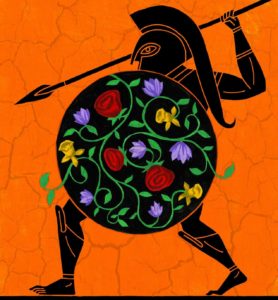Generals have launched spring offensives from ancient times to the Taliban era

ILLUSTRATION: THOMAS FUCHS
‘When birds do sing, hey ding a ding, ding; Sweet lovers love the spring,” wrote Shakespeare. But the season has a darker side as well. As we’re now reminded each year when the Taliban anticipate the warm weather by announcing their latest spring offensive in Afghanistan, military commanders and strategists have always loved the season, too.
The World War I poet Wilfred Owen highlighted the irony of this juxtaposition—the budding of new life alongside the massacre of those in life’s prime—in his famous “Spring Offensive”: “Marvelling they stood, and watched the long grass swirled / By the May breeze”—right before their deaths.
The pairing of rebirth with violent death has an ancient history. In the 19th century, the anthropologist James George Frazer identified the concept of the “dying and rising god” as one of the earliest cornerstones of religious belief. For new life to appear in springtime, there had to be a death or sacrifice in winter. Similar sacrifice-and-rejuvenation myths can be found among the Sumerians, Egyptians, Canaanites and Greeks.
Mediterranean and Near Eastern cultures saw spring in this dual perspective for practical reasons as well. The agricultural calendar revolved around wet winters, cool springs and very hot summers when almost nothing grew except olives and figs. Harvest time for essential cereal crops such as wheat and barley took place in the spring. The months of May and June, therefore, were perfect for armies to invade, because they could live off the land. The Bible says of King David, who lived around 1,000 B.C., that he sent Joab and the Israelite army to fight the Ammonites “in the spring of the year, when kings normally go out to war.”
It was no coincidence that the Romans named the month of March after Mars, the god of war but also the guardian of agriculture. As the saying goes, “An army fights on its stomach.” For ancient Greek historians, the rhythm of war rarely changed: Discussion took place in the winter, action began in spring. When they referred to a population “waiting for spring,” it was usually literary shorthand for a people living in fear of the next attack. The military campaigns of Alexander the Great (356-323 B.C.) into the Balkans, Persia and India began with a spring offensive.
In succeeding centuries, the seasonal rhythms of Europe, which were very different from those of warmer climes, brought about a new calendar of warfare. Europe’s reliance on the autumn harvest ended the ancient marriage of spring and warfare. Conscripts were unwilling to abandon their farms and fight in the months between planting and harvesting.
Gustavus died before he could fully implement his ideas. This revolution in military affairs fell instead to Frederick the Great, king of Prussia (1712-1786), who turned military life into a respectable upper-class career choice and the Prussian army into a mobile, flexible and efficient machine.
Frederick believed that a successful army attacks first and hard, a lesson absorbed by Napoleon a half century later. This meant that the spring season, which had become the season for drilling and training in preparation for summer campaigning, became a fighting season again.
But the modern iteration of the spring offensive is different from its ancient forebear. Its purpose isn’t to feed an army but to incapacitate enemies before they have the chance to strike. The strategy is a risky gambler’s throw, relying on timing and psychology as much as on strength and numbers.
For Napoleon, the spring offensive played to his strength in being able to combine speed, troop concentration and offensive action in a single, decisive blow. Throughout his career he relied on the spring offensive, beginning with his first military campaign in Italy (1796-7), in which the French defeated the more-numerous and better-supplied Austrians. His final spring campaign was also his boldest. Despite severe shortages of money and troops, Napoleon came within a hair’s breadth of victory at the Battle of Waterloo on June 18, 1815.
The most famous spring campaign of the early 20th century—Germany’s 1918 offensive in World War I, originated by Gen. Erich Ludendorff—reveals its limitations as a strategy. If the knockout blow doesn’t happen, what next?
In this century, the Taliban have found their own brutal way to renew the ancient tradition—with the blossoms come the bombs and the bloodshed.





